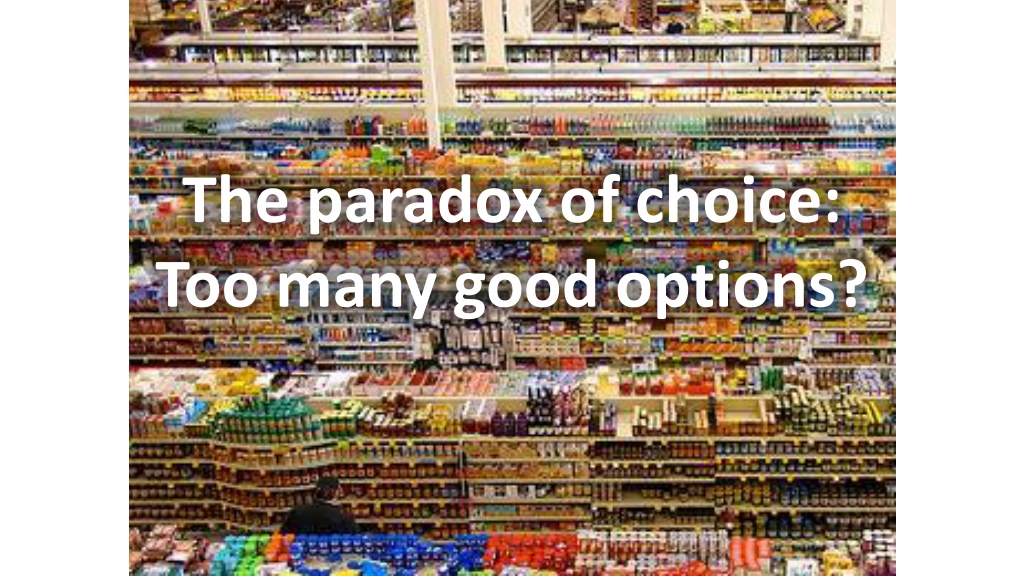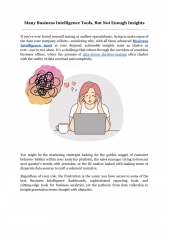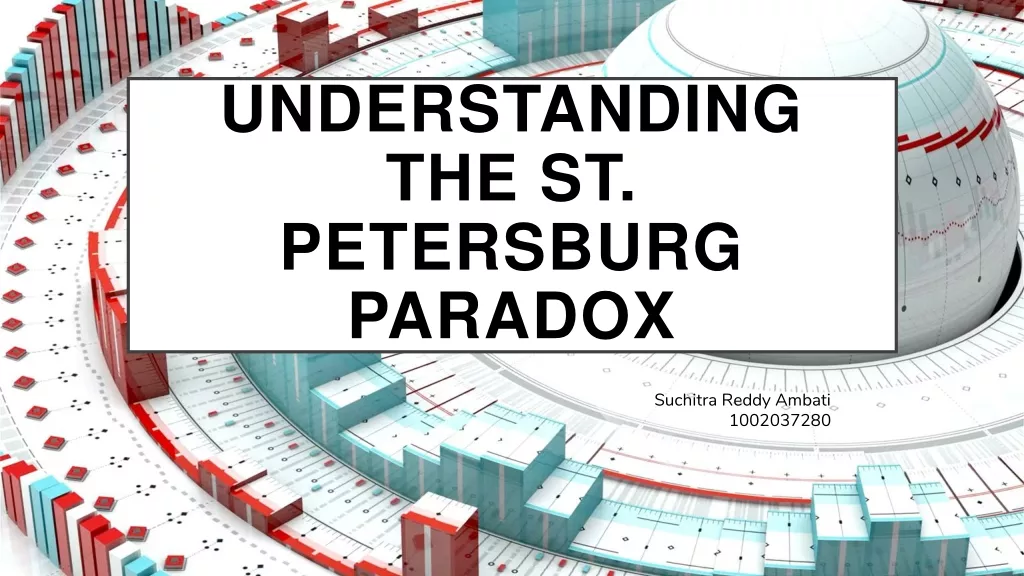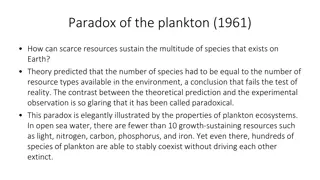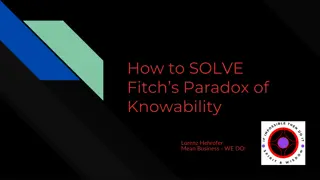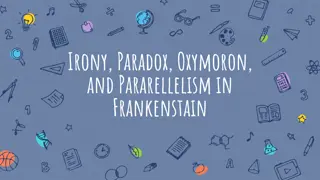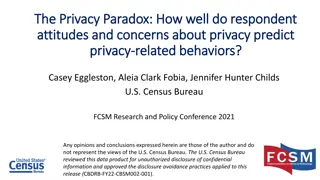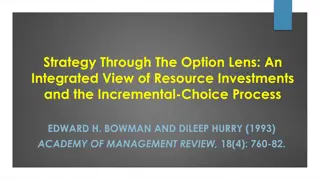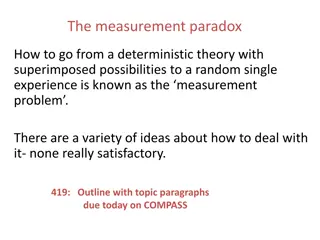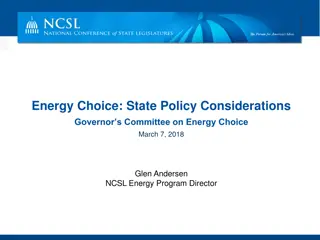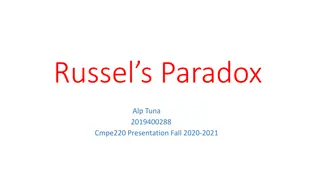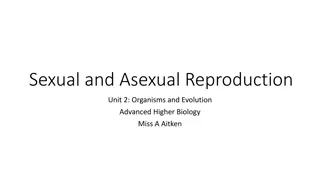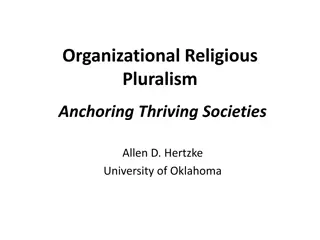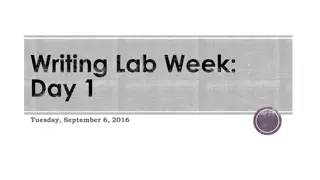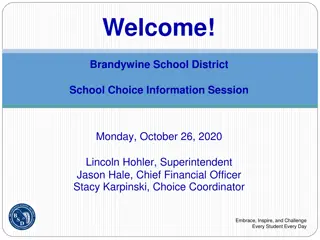The Paradox of Choice: Too Many Good Options?
The paradox of choice delves into the debate between standard economics supporting the benefits of numerous options and experimental findings suggesting that hyperchoice can lead to decision paralysis and decreased satisfaction. While more choices may seem advantageous, excessive options can have negative consequences on decision-making and satisfaction levels.
Download Presentation

Please find below an Image/Link to download the presentation.
The content on the website is provided AS IS for your information and personal use only. It may not be sold, licensed, or shared on other websites without obtaining consent from the author.If you encounter any issues during the download, it is possible that the publisher has removed the file from their server.
You are allowed to download the files provided on this website for personal or commercial use, subject to the condition that they are used lawfully. All files are the property of their respective owners.
The content on the website is provided AS IS for your information and personal use only. It may not be sold, licensed, or shared on other websites without obtaining consent from the author.
E N D
Presentation Transcript
The paradox of choice: Too many good options?
Standard economics: lots of choice is good
Experimental findings: Hyper-choice can be bad
In standard economics, more choice is always better because I can simply ignore the less desirable choices < <
Diminishing marginal utility and choice variety in standard economics We ve just seen that the addition of choices is thought to be clearly superior when existing choices remain available. Another reason why the availability of more choices is desirable is diminishing marginal utility. Hot Dogs Consumed Utility from Each Hot Dog 1 +10 2 3 +4 0 4 -1 5 6 -4 -10
Greater availability of tempting options leads to greater consumption. But otherwise, more options are always a good thing, right?
Hyperchoice and the choice paradox We think more choice is better, but there can be problems with excessive choice: 1. Decisions become less likely (paralysis) 2. Choice satisfaction drops
Too many choices can lead to paralysis http://www.youtube.com/watch?v=V O6XEQIsCoM 0:25-9:57
The Jam Experiment A Tasting booth for unusual jams in an upscale grocery story. A: offered 6 jams B: offered 24 jams What percentage of tasters later purchased one of the jams? B Iyengar, S. (Columbia) & Lepper, M. (Stanford), 2000, When choice is demotivating: Can one desire too much of a good thing. Journal of Personality and Social Psychology, 79, 995-1006
The Jam Experiment On two consecutive Saturdays, neither of which fell on a long holiday weekend, a tasting booth was set up inside the grocery store. Over the course of these two 5-hr experimental periods, the behavior of approximately 754 shoppers was observed. Among the 386 customers present in the store during the hours when the extensive-choice booth was displayed, only 242 (63%) actually encountered the display. Among the 368 customers present in the store during the hours when the limited-choice booth was displayed, only 260 (71%) actually encountered the display.
The Jam Experiment Of the 242 customers who passed the extensive-selection display of jams, 60% (145) actually stopped at the booth. In contrast, of the 260 customers who passed the limited- selection display of jams, only 40% (104) stopped. Thus, consumers who encountered the extensive-choice condition were more attracted to the booth than consumers exposed to the limited-choice condition, suggesting that the variety provided in the extensive-choice condition was initially more attractive
The Jam Experiment One might imagine that consumers who encountered 24 different jams would sample more flavors than would those who encountered 6 different varieties. In fact, however, there were no significant differences.
The Jam Experiment Nearly 30% (31) of the consumers in the limited-choice condition subsequently purchased a jar In contrast, only 3% (4) of the consumers in the extensive- choice condition did so Thus, consumers initially exposed to limited choices proved considerably more likely to purchase the product than consumers who had initially encountered a much larger set of options.
Decision paralysis 30% A Tasting booth for unusual jams in an upscale grocery story. A: offered 6 jams B: offered 24 jams What percentage of tasters later purchased one of the jams? B 3% Iyengar, S. (Columbia) & Lepper, M. (Stanford), 2000, When choice is demotivating: Can one desire too much of a good thing. Journal of Personality and Social Psychology, 79, 995-1006
Decision paralysis 40% A What percentage of shoppers stopped at the display? Shoppers were more attracted to greater variety, but were less likely to actually make a decision. B 60% Iyengar, S. (Columbia) & Lepper, M. (Stanford), 2000, When choice is demotivating: Can one desire too much of a good thing. Journal of Personality and Social Psychology, 79, 995-1006
An extra credit writing assignment in a class at Stanford: some sections had 6 topic options. Others had 30 topic options. Which sections were most likely to complete the essay? Iyengar, S. (Columbia) & Lepper, M. (Stanford), 2000, When choice is demotivating: Can one desire too much of a good thing. Journal of Personality and Social Psychology, 79, 995-1006
6 topics available 74% completed 30 topics available 60% completed And grades for both content and form were significantly higher for the few- choices group. Iyengar, S. (Columbia) & Lepper, M. (Stanford), 2000, When choice is demotivating: Can one desire too much of a good thing. Journal of Personality and Social Psychology, 79, 995-1006
800,000 eligible employees at 657 companies 401(k) plans ranged from 2 to 60 investment options As choices increased what happened to the likelihood of investing? a) Decreased b) Increased c) Stayed the same
S. Botti (Cornell) & S. S. Iyengar (Columbia), 2006, The dark side of choice: When choice impairs social welfare. Journal of Public Policy and Marketing, 25(1), 24-38.
Choice paradox and satisfaction http://www.youtube.com/watch?v=VO6XEQIsCoM Barry Schwartz. 9:57-17:20
An experiment with two digital video player versions Before use, which had higher rating of How satisfied would you be if you subscribed to the digital player? a) Few features (7) b) Many features (21) c) No difference
An Experiment with Digital Video Players 6 5.5 5 Low Features High Features 4.5 4 3.5 3 Expected satisfaction D. Thompson (U. Maryland), R. Hamilton (U. Maryland), R. Rust (U. Maryland), 2005, Feature fatigue: When product capabilities become too much of a good thing. Journal of Marketing Research, 42, 432-442.
An experiment with two digital video player versions After use, which had higher rating of How satisfied were you with the digital player you used? a) Few features (7) b) Many features (21) c) No difference
An Experiment with Digital Video Players 6 5.5 5 Low Features High Features 4.5 4 3.5 3 Expected satisfaction Actual satisfaction D. Thompson (U. Maryland), R. Hamilton (U. Maryland), R. Rust (U. Maryland), 2005, Feature fatigue: When product capabilities become too much of a good thing. Journal of Marketing Research, 42, 432-442.
Do more television options make you better off? 72,012 respondents from 24 nations with varying numbers of available television stations Comparing among those with similarly high or low levels of television watching compared with group norms
C. Benesch(U. of Zurich), B. Frey (U. Zurich), & A. Stutzer (U. Basel), 2006, TV Channels, Self Control and Happiness, Working Paper - Institute for Empirical Research in Economics, University of Zurich
Choice paradox and satisfaction No choice can be bad. Excessive choice can also be bad. satisfaction Limited choice may be best. Number of choices
Participants choosing from a selection of 30 chocolates instead of 6 chocolates were more dissatisfied and regretful of the choices they made. Iyengar, S. (Columbia) & Lepper, M. (Stanford), 2000, When choice is demotivating: Can one desire too much of a good thing? Journal of Personality and Social Psychology, 79, 995-1006
Participants were given a picture representing a set of gift boxes with a certain number of alternatives. They were asked to choose the gift box they would buy to pack a present for a friend.
Different people were tested with different numbers of gift box options. According to standard economic theory, which group should be the happiest with their selected option? a) 5 options b) 10 options c) 15 options d) 30 options
Different people were tested with different numbers of gift box options. When asked afterwards, which group actually reported the highest satisfaction with their choice? a) 5 options b) 10 options c) 15 options d) 30 options
E. Reutskaja (IESE) & R. Hogarth (Universitat Pompeu Fabra-Barcelona), 2009, Satisfaction in Choice as a Function of the Number of Alternatives: When Goods Satiate. Psychology and Marketing, 26(3), 197-203.
When asked afterwards, which group most enjoyed the process of selecting the box? a) 5 options b) 10 options c) 15 options d) 30 options
E. Reutskaja (IESE) & R. Hogarth (Universitat Pompeu Fabra-Barcelona), 2009, Satisfaction in Choice as a Function of the Number of Alternatives: When Goods Satiate. Psychology and Marketing, 26(3), 197-203.
Breaking apart the choice paradox E. Reutskaja (IESE) & R. Hogarth (Universitat Pompeu Fabra-Barcelona), 2009, Satisfaction in Choice as a Function of the Number of Alternatives: When Goods Satiate. Psychology and Marketing, 26(3), 197-203.
Increases time spent contemplating negative results Attaches personal responsibility to the negative outcome When all options are negative, even limited choice can be undesirable
An experiment with unpleasant yogurt flavors: sage, chili powder, tarragon, or celery seeds Either asked to pick one or told they would be given one randomly.
Did you like the fact that you were given a choice? 5.50 agreement Did you like the fact that you did not have to choose? 4.41 agreement But, did choice result in greater satisfaction? a) Yes b) No c) Made no difference S. Botti (U. Chicago) & S. Iyengar (Columbia U.), 2004, The psychological pleasure and pain of choosing: When people prefer choosing at the cost of subsequent outcome satisfaction. Journal of Personality and Social Psychology, 87(3), 312-326.
3.4 3.2 Satisfaction with Yogurt 3.23 3 2.8 2.6 2.4 2.44 2.2 2 No Choice Choice Not too many options here (only 4), but all options were negative S. Botti (U. Chicago) & S. Iyengar (Columbia U.), 2004, The psychological pleasure and pain of choosing: When people prefer choosing at the cost of subsequent outcome satisfaction. Journal of Personality and Social Psychology, 87(3), 312-326.
Although increased choice is perceived as desirable, in some circumstances, the provision of choice either inhibits decision makers likelihood to make a choice or detrimentally affects their experienced well-being after the choice is made. S. Botti (Cornell) & S. Iyengar (Columbia), 2006, The dark side of choice: When choice impairs social welfare. Journal of Public Policy and Marketing, 25(1), 24-38.
Simplicity v. Variety Sometimes too many options can make decisions difficult. may lead to doing nothing. are more likely to cause regret.
